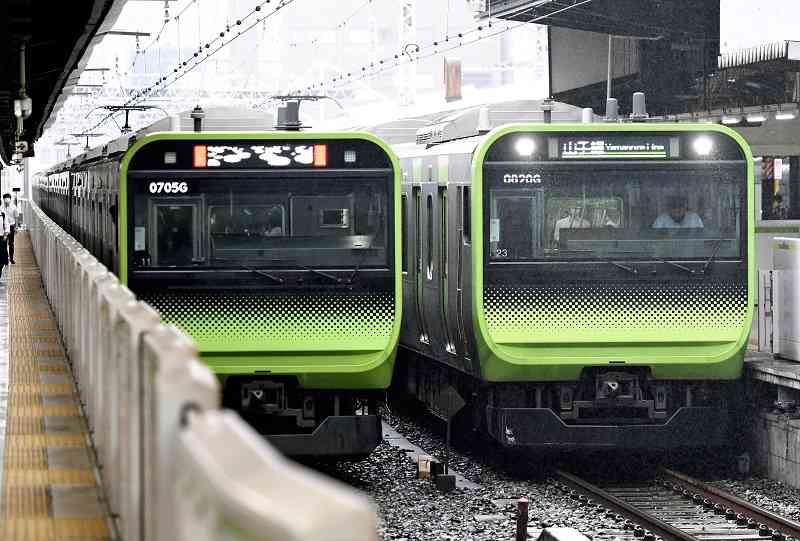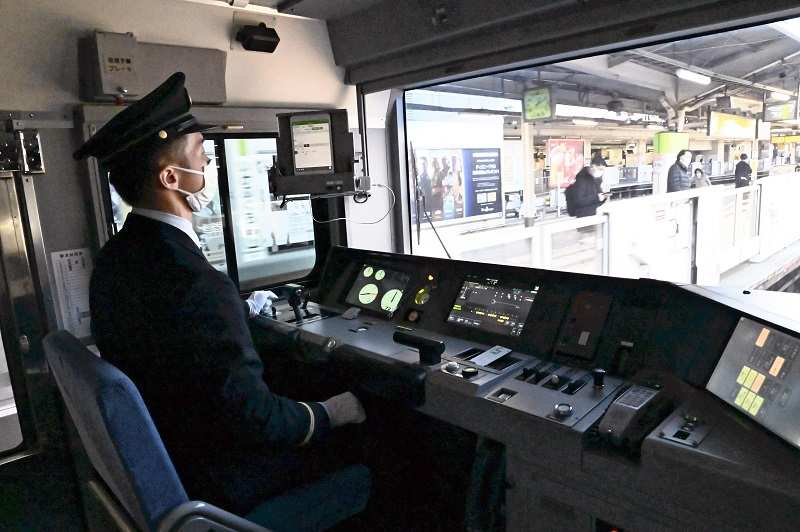All aboard driverless trains: JR East to test automation system on Tokyo loop line in October

Yamanote Line trains are seen at JR Yurakucho Station.
1:00 JST, September 13, 2022
Self-driving trains will be operating on Tokyo’s Yamanote Line in October during a trial of an automation system that East Japan Railway Co. hopes to roll out in 2028.
A driver and conductor will be on board in the initial stages, but JR East aims to have one operator per train or even unmanned services in the future.
The Yamanote Line will utilize Level 2 automation, marking the first full-scale trial at that level on a railway line with railroad crossings and a large number of passengers.
There are five internationally-recognized levels used to describe train automation, from Level 0 — manual operation with no automatic train protection — to Level 4 — unattended train operation.
Every 3 minutes
During rush hour in the morning, Yamanote Line trains stop every three minutes at Yurakucho Station in Chiyoda Ward, Tokyo. Earlier this month a JR East official there explained the aims of the automation trial.
“At first, we’ll run two 11-car trains and collect data for analysis,” the official said.
The automation system, which controls acceleration and deceleration, and automatically applies the brakes when a train approaches a station, is linked to the Yamanote Line’s signaling system.
The driver’s main role will be to respond in an emergency, such as a person on the tracks or a car stuck on a railroad crossing.
JR East will observe passenger conditions and energy efficiency during the trial and will use the results to make improvements in the future.
The Yamanote Line trial in October will utilize Level 2 automation, under which crew members are in the cab but driving is controlled by the system. In Level 3 automation, the driver’s cab is unattended but crew members are on board the train.
Level 4 automation, which involves completely unmanned operation, is currently in use on the Yurikamome line, which connects the Tokyo districts of Shinbashi and Toyosu.
Even though Japan’s first automated transit system, the Port Liner, was launched in Kobe in 1981, from the viewpoint of safety, full-scale rollouts on transit systems with railroad crossings, complex routes and high passenger numbers have been seen as a challenge.
Level 2 automation has already been implemented on some Tokyo Metro lines and the Tsukuba Express line. West Japan Railway Co. is also conducting self-driving tests on the Osaka Loop Line. However, none of those lines have railroad crossings that are easily accessible by pedestrians.
The Yamanote Line has one railroad crossing.
“If we can make the self-driving system work on a line with a crowded timetable, we can do it on other lines,” JR East said.
Labor challenges

A driver sits is seen at the controls of a Yamanote Line train during an automated driving trial in February.
One of the main advantages of automatic train operation is labor savings, even at Level 2. Although an operator still needs to be in the driver’s cab, the workload is reduced. The driver can operate the doors and do other tasks usually handled by a conductor, so that role will no longer be required.
JR East plans to have one operator per train on the Yamanote Line by around 2030.
According to statistics from the Land, Infrastructure, Transport and Tourism Ministry, the number of railway employees such as drivers, conductors and station staff was 151,885 in fiscal 2019, down from 160,997 seven years earlier.
The country’s working-age population — ages 15-64 — is expected to decline from 74.06 million in 2020 to 52.75 million in 2050, according to the National Institute of Population and Social Security Research.
“Automated driving technology will allow the limited number of personnel to focus on services that only humans can provide,” a JR West official said.
Safety measures
Systems with Level-2 automation operate trains under pre-determined conditions. Level-3 automation is fundamentally different as a central control center is responsible for remotely controlling multiple trains.
JR East hopes to roll out Level 3 automation in the 2030s.
But before the step up to more advanced levels can be made on lines as complex as the Yamanote, a major artery that circles central Tokyo, it will be necessary to develop a system that can manage the operation of the entire line.
It will also be necessary to implement safety measures such as platform doors at every station and roll out technology that can automatically detect people or obstacles on tracks. JR East and Tobu Railway Co. are developing systems that utilize cameras on the exterior of trains for such purposes.
“While it is technically possible to run train cars remotely, a system that can smoothly guide evacuation procedures in the event of a disaster or on-board trouble will also be needed to ensure safe operations,” said railway expert Prof. Ryo Takagi of Kogakuin University. “Even if there are still technical challenges, however, the benefits of eliminating the need for a driver are significant. Technological developments by railway companies are likely to increase in the future.”




